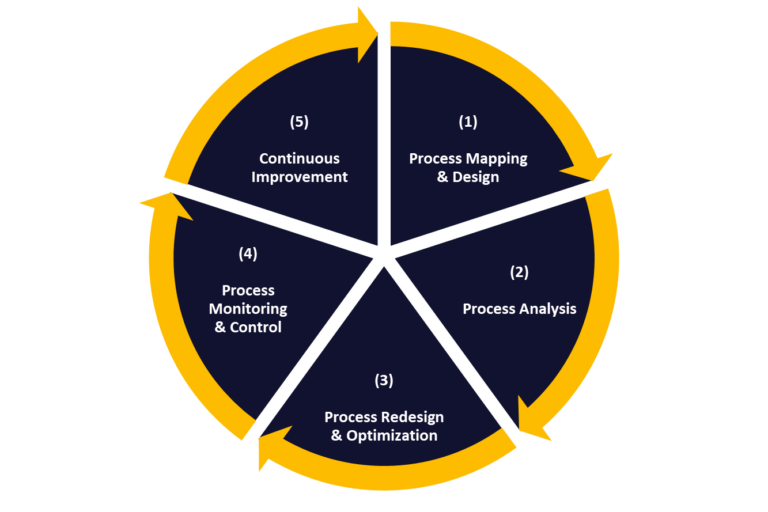Business Process Management (BPM) is a comprehensive approach and framework to optimize, manage, and continuously improving an organization’s business processes. As organizations grow and become more complex, BPM plays a pivotal role in enhancing operational efficiency, productivity, and overall performance.
An effective BPM strategy actively involves cross-functional teams in the quest for operational excellence, cultivating a culture dedicated to ongoing enhancement. Although BPM is a widely recognized acronym and business methodology, numerous large-scale enterprises have yet to harness the enhanced transparency and governance that BPM principles offer, setting them apart from their rivals.
BPM consists of many areas but here are five everyone should be familiar with:

The 5 Areas Everyone Should Know
(1) Process Mapping & Modeling
BPM begins with identifying and documenting existing business processes. This often involves creating process maps and models to visualize how activities, tasks, and information flow within the organization and distinct process.
(2) Process Analysis
After mapping processes, BPM experts perform an analysis to identify bottlenecks, inefficiencies, and areas for improvement. This analysis helps in setting performance benchmarks and creating focal areas for discussions.
(3) Process Redesign & Optimization
Once problem areas are identified, BPM analysts and the business process core resources redesign and optimize processes to eliminate waste, reduce costs, and enhance overall effectiveness. This can involve automation, simplification, and reengineering of workflows.
(4) Process Monitoring & Control
BPM incorporates systems and tools for monitoring process performance in real-time. This allows organizations to quickly identify deviations from established benchmarks and take corrective action when necessary.
(5) Continuous Improvement
BPM is an ongoing effort. It involves a culture of continuous improvement where processes are regularly reviewed, refined, and optimized to adapt to changing business conditions and customer needs.
Top Five Benefits of Business Process Management
- Improved Efficiency and Productivity: BPM identifies bottlenecks, eliminates redundancies, and streamlines processes, leading to increased operational efficiency and productivity. This can result in cost savings and faster task completion.
- Enhanced Quality and Consistency: BPM emphasizes standardization and quality control, ensuring that processes are executed consistently. This minimizes errors, reduces rework, and improves the overall quality of products or services.
- Greater Visibility and Control: BPM provides real-time monitoring and reporting, offering insights into process performance. This visibility enables organizations to make informed decisions, detect issues early, and make timely adjustments.
- Agility and Adaptability: BPM supports process agility, allowing organizations to quickly adapt to changing market conditions, customer preferences, or regulatory requirements. It fosters a culture of continuous improvement and innovation.
- Compliance and Risk Management: BPM helps organizations ensure that their processes comply with regulatory standards and industry best practices. It also aids in identifying and mitigating potential risks, thereby reducing legal and financial liabilities.
Why is BPM Important?
For businesses to cultivate a sustainable competitive edge and maximize key KPIs, it is imperative that their internal operational processes and customer interactions are not only effective but also highly efficient. Business Process Management (BPM) serves as the toolkit that organizations employ to achieve the desired levels of optimization and performance.
Modern BPM goes beyond mere performance enhancement; it encompasses critical aspects such as governance (decision-making), risk management, compliance, and organizational agility. In today’s dynamic business landscape, companies need the capability to swiftly and securely adapt to emerging opportunities and address potential risks, all while maintaining a steadfast strategic direction.
Business process management serves as the linchpin for achieving these outcomes by establishing well-defined and consistently executed business processes. When external factors necessitate organizational changes, a robust BPM foundation allows for agile and coordinated adjustments, bolstering the organization’s ability to adapt effectively.
BPM Should Be Continuous
The continuous nature of Business Process Management is essential because it ensures that organizations can adapt to evolving market conditions, customer demands, and regulatory requirements, while consistently striving for operational excellence and sustainable growth. By making BPM an ongoing commitment, businesses can remain competitive, agile, and well-prepared for the challenges of the future.
Interested to find out more? Let’s Chat!

